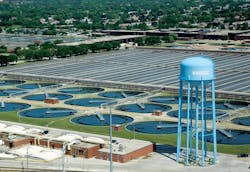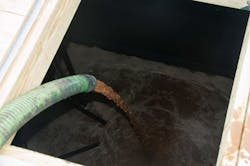Phosphorus Partnerships
The ingredients used to brew beer are few: grain, malt, hops, yeast and water. Combined in the right amounts, these ingredients combine to make a flavorful beverage. However, the brewing process also produces a significant amount of waste. Fortunately, the Metropolitan Water Reclamation District of Greater Chicago (MWRD) has discovered that this waste, a high-strength organic material, contains valuable nutrients that can be converted for beneficial reuse at the MWRD’s Stickney Water Reclamation Plant (WRP).
The Bio-P Program, as the MWRD calls it, is part of the agency’s resource recovery model that provides both economic and environmental benefits.
Brewery Boom
The Chicago metropolitan area is home to more breweries than any other area in the U.S. With 202 local breweries, Chicago out-brews its closest competitors in Denver (198), Seattle (168), Portland (161) and Minneapolis (150). The meteoric rise in craft brewing has led to new opportunities outside the taverns, and the MWRD is transforming water and brewery waste to maximize the recovery of phosphorus.
After extensive research, MWRD staff found that the spent yeast residuals from the beer-making process can be injected into the secondary treatment of water as a readily biodegradable form of carbon; this carbon serves as food for the phosphate- accumulating organisms that work under both anaerobic and aerobic conditions. These organisms remove organic material from wastewater and recover more phosphorus than normal microorganisms. This process is known as enhanced biological phosphorus removal (EBPR).
The bacteria use volatile fatty acids from the converted carbon in the high-strength organic materials to accumulate phosphate causing concentrated sidestreams after secondary treatment. These sidestreams can be treated with MWRD’s new nutrient recovery system that yields a slow-release phosphorus fertilizer product called Crystal Green, which provides a return on investment through its sale.
Local Benefits
The process is both economically and environmentally viable, providing benefits to the Chicago Area Waterway System and downstream to the Mississippi River and the Gulf of Mexico. By removing phosphorus from the water and returning it to farmers and other agricultural producers, this process represents a significant shift in the wastewater industry from treatment to recovery for reuse. Similar to nitrogen, excess phosphorus discharged to waterways can contribute to water quality problems, causing algae to grow and bloom and create conditions that destroy aquatic life and severely limit recreational enjoyment of lakes and rivers.
It is estimated that phosphorus, a non-renewable resource essential for life, may be depleted from reserves within the next 50 years. Most of it is sourced from rock mines and must be transported considerable distances. Similarly, brewing and other organic waste can be hauled great distances for disposal. This is where MWRD steps in. Haulers can now instead head straight to the Stickney or Calumet WRP just outside of downtown Chicago.
After learning about MWRD’s plans, local breweries such as Goose Island Beer Co. and Revolution Brewing lined up to participate. The companies partnered with 1212 Environmental, which specializes in fully managed waste reduction and recycling programs, to have their liquid waste delivered to the MWRD.
“Goose Island got involved with the MWRD’s Bio-P program to enhance their innovative resource recovery program and to support their goal of protecting regional water quality,” said Ian Hughes, assistant brewery manager for Goose Island. “We have a vested interest in clean water because it is one of the most important ingredients we use for making beer; it is the blank canvas upon which our brewers paint their masterpiece with malt, hops and yeast. That being said, we were excited to create an innovative byproduct synergy with our wastewater regulator by diverting our spent yeast from the drain and sending it directly to the MWRD for use in their enhanced biological phosphorus removal and recovery program. It is a win-win partnership as we find a new life for our ‘waste’ byproduct and in the process we support the MWRD’s exciting resource recovery efforts.”
Other Sources
The organic material provided for the EBPR process is not limited to breweries. Restaurants, food processors and candy producers that have waste containing elevated concentrations of chemical oxygen demand, 75,000 mg/L or above, can produce the wanted results. These sugary or starchy wastes are homogenous liquids or slurries high in organic content that typically are too concentrated to be disposed of by discharge to the sewer system.
MWRD verifies that each material delivery will augment and improve its treatment plant operations. To do so, environmental specialists take samples from every delivery and analyze the material to ensure the load meets proper standards for beneficial substances. They also monitor for contaminants that may harm the plant or cause a violation of the MWRD’s NPDES permit. The tanker trucks make a $250 payment for deliveries of 5,000 gal, $50 for a 1,000-gal delivery or $25 for a 500-gal delivery.
“Not only is our Bio-P program a major victory for the water environment, but it’s a victory for local businesses looking to lower their fuel and employee costs while reducing their greenhouse gas emissions and carbon footprint,” said Mariyana Spyropoulos, president of MWRD. “We credit our staff who researched this effort for two years, testing materials and finding potential candidates to provide this critical ingredient that will help us recover more phosphorus from the water treatment process.”
Brewery waste, a high-strength organic material, is transferred into an MWRD distribution chamber. This waste will improve and stabilize the MWRD’s enhanced biological phosphorus removal process during treatment.

